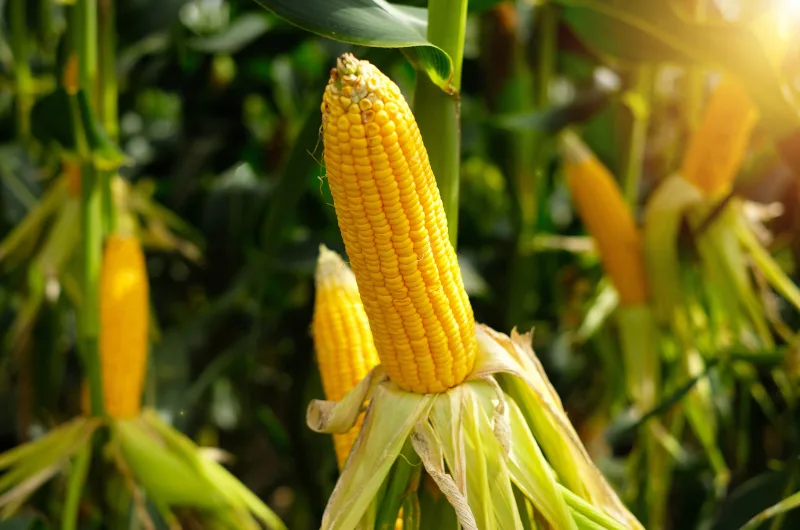How Top Grow Sweetcorn
Growing sweetcorn (Zea mays var. saccharata) in the United Kingdom might not be the first crop that comes to mind, but with the right care and attention, you can enjoy the delightful taste of fresh, homegrown sweetcorn on your dinner table. While it’s true that sweetcorn thrives in warmer climates, it’s entirely possible to cultivate this sweet and savoury delight in British gardens. In this comprehensive guide, we will take you through the steps of how to grow sweetcorn successfully in the UK, from selecting the right varieties to harvesting your corn cobs at the peak of sweetness.
Choosing the Right Varieties
Before you get your hands dirty, it’s essential to select the right sweetcorn varieties suited for British growing conditions. In the UK, you’ll generally want to opt for early maturing or “super sweet” varieties, as our climate is relatively short on heat. Some popular choices include:
- Lark: This early-maturing variety produces sweet, tender kernels and is well-suited to the British climate.
- Swift: Swift is another early variety that adapts well to cooler conditions and provides excellent taste and texture.
- Incredible: Although not as early as Lark or Swift, Incredible is known for its superb flavour and adaptability to cooler summers.
- Sweet Nugget: A super sweet variety, Sweet Nugget, is an excellent choice for those looking for intense sweetness and tenderness.
- Mirai: Mirai varieties are renowned for their superb flavour and high sugar content, making them ideal for UK gardens.
Remember that sweetcorn varieties are often classified as either normal (SU) or supersweet (SH2). Supersweet varieties tend to stay sweeter for more extended periods after harvest, but they can be trickier to grow, especially in the UK’s cooler climate. Normal varieties, like those listed above, are often easier to manage and still offer fantastic taste.
Selecting the Perfect Spot
Sweetcorn is a sun-loving plant, so selecting the right spot in your garden is crucial for a successful harvest. Choose an area that receives at least 6-8 hours of direct sunlight daily. Additionally, consider the following factors when selecting your sweetcorn plot:
- Soil Quality: Sweetcorn thrives in well-draining, fertile soil with a pH level between 6.0 and 6.8. Amending your soil with organic matter, such as compost, can improve its fertility and water retention capabilities.
- Wind Protection: Corn plants can be susceptible to wind damage, so choose a location with natural windbreaks like fences or other plants to shield them.
- Spacing: Allow enough space between rows and plants to ensure good air circulation and prevent overcrowding. Plant sweetcorn in blocks rather than single rows for better pollination.
Preparing and Planting
Now that you’ve chosen your sweetcorn varieties and a suitable location, it’s time to get your hands dirty and start planting.
- Soil Preparation: Prepare your soil by tilling it to a depth of around 6 inches. Incorporate well-rotted compost or organic matter to improve soil fertility and structure.
- Planting Time: In the UK, it’s best to wait until the last frost has passed, typically around late April to early May, before planting sweetcorn. Planting too early can lead to cold damage or poor germination. Sweetcorn can be direct sown, but you’ll improve the chances of a healthy crop by sowing indoors and transplanting seedlings out once frosts have passed.
- Planting Depth: Sow sweetcorn seeds about 1 inch deep and 9-12 inches apart in rows. Leave approximately 24-36 inches between rows. For optimal pollination, plant sweetcorn in blocks of at least four rows.
- Watering: Keep the soil consistently moist but not waterlogged. Water deeply and evenly to encourage strong root development.
Caring for Your Sweetcorn
Once your sweetcorn is in the ground, it’s time to take good care of it throughout the growing season. Here are some essential tips:
- Fertilisation: Sweetcorn is a hungry crop, so regular fertilisation is essential. Apply a balanced, slow-release fertiliser when planting and side-dress with nitrogen-rich fertilizer when the plants are knee-high and again when they tassel.
- Weeding: Keep the area around your sweetcorn plants weed-free to prevent competition for nutrients and water.
- Mulching: Applying a layer of mulch around your sweetcorn plants can help retain soil moisture and suppress weeds.
- Pest and Disease Management: Monitor your sweetcorn for common pests like corn earworms and aphids. Consider using organic pest control methods, such as releasing beneficial insects or using neem oil, to manage infestations. Also, practice crop rotation to reduce the risk of soil-borne diseases.
- Support: As your sweetcorn plants grow, they may become top-heavy and susceptible to strong winds. Stake or support your plants with garden twine to prevent damage.
- Watering: Sweetcorn requires consistent moisture, especially during the flowering and pollination stages. Water deeply during dry spells to ensure healthy development.
Pollination is a crucial factor in sweetcorn production. Sweetcorn plants are wind-pollinated, and proper pollination is necessary for full kernel development on each cob. To enhance pollination:
- Plant in Blocks: As mentioned earlier, planting sweetcorn in blocks rather than single rows increases the chances of successful pollination.
- Planting Timing: Try to stagger your planting over a few weeks to ensure that your sweetcorn tassels at different times, increasing the chances of cross-pollination.
- Shake the Tassels: When the male tassels (at the top of the plant) release pollen, gently shake them to help distribute it onto the female silk (coming from the developing cobs).
Harvesting Sweetcorn
One of the most rewarding moments for a sweetcorn grower is the harvest. Sweetcorn is at its best when picked at the peak of ripeness. Here’s how to know when your sweetcorn is ready:
- Timing: Sweetcorn is usually ready for harvest 75 to 90 days after planting. You can tell it’s ready when the kernels are plump, milky, and exude a sweet aroma when pierced.
- Check the Silk: Another indicator is the appearance of the silk at the top of the cob. When it turns brown and starts to dry out, your sweetcorn is nearing maturity.
- Feel the Kernels: Gently squeeze a kernel; if it releases a milky liquid, it’s ready to harvest.
- Appearance: The kernels should be well-filled and evenly spaced on the cob.
To harvest sweetcorn, grasp the cob firmly and twist it while pulling it downward to detach it from the plant. Use a sharp knife to remove any remaining husks and silk. Sweetcorn is best when consumed immediately after harvest, as its sugar content diminishes rapidly once picked.
Storing and Enjoying Your Sweetcorn
If you can’t consume all your sweetcorn at once, there are several ways to store it:
- Refrigeration: Sweetcorn can be stored in the refrigerator for a few days, but it’s best to consume it as soon as possible for the freshest taste.
- Blanch and Freeze: To preserve sweetcorn for an extended period, blanch the cobs in boiling water for a few minutes, then plunge them into ice water. Cut the kernels from the cob and freeze them in airtight containers.
- Canning: If you’re into home canning, you can also pressure can sweetcorn for long-term storage.
Now that you’ve successfully grown and harvested your sweetcorn, it’s time to enjoy the fruits of your labour. Sweetcorn can be enjoyed in various ways:
- Boiling: The most common method of cooking sweetcorn is to boil it. Simply add the cobs to a pot of boiling water, cook for 5-7 minutes, and serve with a dollop of butter and a sprinkle of salt.
- Grilling: Sweetcorn can be grilled for a smoky flavor. Brush the cobs with olive oil, sprinkle with seasonings, and grill for about 15 minutes, turning occasionally until the kernels are tender and slightly charred.
- Roasting: Roasting sweetcorn in the oven is another delicious option. Preheat your oven to 425°F (220°C), place the cobs on a baking sheet, and roast for 20-25 minutes, turning once, until they’re tender and lightly browned.
- Creamed Corn: For a creamy side dish, cut the kernels from the cob and simmer them in a mixture of butter, cream, and seasoning until they’re soft and flavourful.
Growing sweetcorn in the United Kingdom may pose some challenges due to the cooler climate, but with the right selection of varieties, proper care, and attention to detail, you can enjoy the delightful taste of homegrown sweetcorn in your British garden. From choosing the right spot to planting, pollinating, and harvesting, each step plays a crucial role in your sweetcorn’s success. So, roll up your sleeves, grab your gardening tools, and get ready to savour the sweet rewards of your labour – a plateful of delicious, homegrown sweetcorn at its finest.



